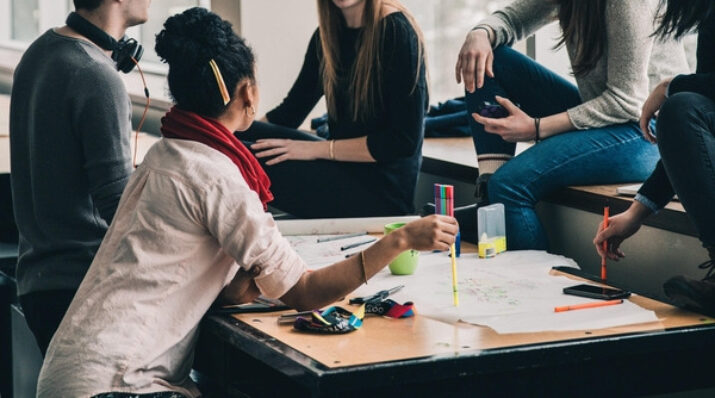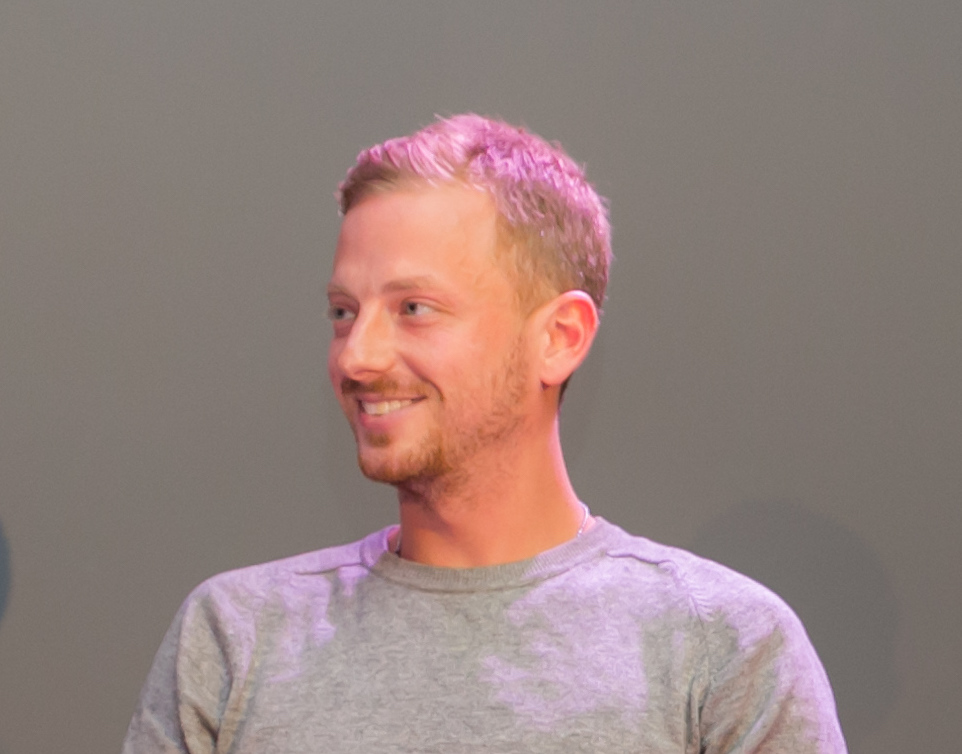Designing for Equity
Building Collaborative Learning Environments in an Inquiry-Based Community School
Topics

Together, educators are doing the reimagining and reinvention work necessary to make true educational equity possible. Student-centered learning advances equity when it values social and emotional growth alongside academic achievement, takes a cultural lens on strengths and competencies, and equips students with the power and skills to address injustice in their schools and communities.
Lyel Resner, principal at New World Learning, interviews the founders of Compass Charter School about building a true community school, elevating empathy, and what leaves them hopeful.
We are living in deeply polarized times. The last presidential cycle has illustrated how hard it has become to identify with fellow citizens whose experiences and ideas differ from our own. The lack of opportunities for people from different backgrounds to learn, play, and grow together has created an empathy deficit in across our country.
This phenomenon is more than just a blue-state/red-state, urban/rural divide. Right here in New York City, we’ve constructed one of the most segregated school districts in the nation. Very few school models actively court and serve students that reflect the true breadth of our city.
The founders of Compass Charter School, a progressive community school in Brooklyn, set out to do just that. I had the privilege of interviewing their cofounders, Brooke Peters, Michelle Healy, and Todd Sutler, to talk to them about strategies and challenges of building a true community school, elevating empathy in the school model, and what leaves them hopeful when children engage in inquiry and connect across difference.
Lyel: Thank you so much or taking the time. Can you tell us a bit about the mission of Compass?
Michelle: Compass is a Brooklyn-based charter school in its fourth year of operations. We started the school with the mission to provide a safe and nurturing learning environment to kids while also promoting a curriculum of inquiry ... where students have a lot of choice in their own learning in tandem with standards based instruction.
We want students to be a part, and see themselves as part, of a community and take action when it's needed.
Brooke: We all believe that kids come to kindergarten with their own wealth of knowledge about the world. We provide opportunities to share their knowledge with each other, and to share themselves in terms of their culture and identity. There are lots of opportunities for students to do the type of work where they are developing socially and emotionally as well as academically.
Lyel: What does it mean to you to be a community school?
Michelle: In basic terms, it means serving children that are living in the neighborhood. The majority of our students are from this community. The things we are teaching at the school are directly related to our neighborhood.
Todd: Community schools are a buzzword these days. We’re talking about how we support and care for students, staff, and extended families of our students. The thinking is that the better positioned the family is, the better prepared a student is to participate in their learning, but also that ... it’s just right to take care of each other.
We allocate staff members work time (for things like) calling families to see if there are any roadblocks to get to the welcome party. We feel that is a priority that needs to be met in order properly serve the diverse community that we have. It means meeting the needs of all of the stakeholders in the organization that is serving the kids’ learning.
Brooke: In a community that functions really well, people know each other really well, and know each other deeply. And there are a number of specific things we do to allow for that.
Lyel: What are some of the challenges of working in a socioeconomically diverse community?
Todd: It can be challenging for families to think about the needs and perspectives of others. That is something, actually, we are working on with our elementary school students. We believe it is a unique thing we are trying to do… which is unfortunate. As a result, adults, generally, are not very good at it. So we have community members (families and staff, including ourselves) who need reminders of all the different needs and perspectives that exist in our community.
Brooke: It can be difficult because people are understandably prioritizing their own children’s needs. Maybe it would not be as challenging if our primary responsibility were something other than educating their children.
But I know that we have parents that have chosen to be here. We don’t turn people away, but we are very clear about our model and about what it is that we do here. They are making a commitment to this type of education when they choose to send their children here.
Michelle: We've been doing a lot of work in terms of how we can get adults in the school building to learn about different perspectives and empathize with different perspectives. We've been planting the seeds for designing different programs for families to participate in, that are more focused on thinking about identity and where we’re all coming from, and just hear what other people are thinking about.
Last year we did a series of workshops on how families were addressing issues like race and class with their kids. Hearing the parents think about how they’re addressing these issues with their kids, and how they’d like for their kids to be treated by others, and what kinds of hopes and dreams they have for their kids. We’re working on creating more of a system for that.
Brooke: The biggest thread through everything that we do is relationships, and in order for us to tackle some of the challenges of bringing diverse group of families and staff together, teachers specifically need to form really strong relationships with the families. We do home visits and ‘listening-conferences’ which set up the relationship to say ‘We’re here for you, we care about you.’
It speaks to not only our inquiry-based philosophy but also that we’re all progressive educators at heart. We really believe in us all coming together to work for what's the best for each child and that each person that's in the child’s life has a really important amount of influence. Too often, unfortunately, the school is just proscribing to the family, versus allowing the family to be a part of the process.
Lyel: Why did you choose to focus on inquiry? How do you plan for inquiry based learning within context of standards based environment?
Michelle: Inquiry is the natural process by which human beings learn. From the time we’re infants we look around, take in the world, and try to make sense of it. As they grow older, that turns into kids asking questions about how things work in the world that they observe. They wonder about things and figure out a way to get answers to things that they’re wondering about. We want to build on the innate pattern of the way that people learn ... we promote wondering within different topics so they can think about what they know, what they want to learn, how are they going to go about learning it.
We think about ways we can immerse kids in the content first so that they begin to have a lot of wonderings.
What we definitely don't want to do ... is to extinguish curiosity for kids … we want to have kids spark their own curiosity and think about how their own voice plays into what they are learning.
That promotes creativity. This creates a set of skills that are much more needed in the world today ... looking at something and thinking how am i going to learn this? Then guiding yourself through it.
Lyel: This is a nuanced approach to curriculum design and execution. Does the diversity of your population of students influence your pedagogy?
Michelle: We have consciously decided to place ourselves in a really diverse area—in every way possible...in terms of race and class and socioeconomics, culture ... it's fascinating to do this inquiry-based curriculum with all of these factors in mind. We have kids across the range of learning and development. Inquiry helps to open that [the diversity up], and allows to us to be able to give kids what they need. It is really challenging.
It is really challenging to use our co-teaching model to make sure every kid gets exactly what they need at exactly the right time ... it's a high level of planning ... and our teachers love to do it. That's why we're here, to do that type of work.
Brooke: Another key reason for starting the school is that we’re all teachers. And being a teacher today ... there is a trend around bashing teachers, and we’re thinking about elevating the status of the teacher and also thinking about all the skills that teachers need in order to teach in a way that does not extinguish the curiosity flame for kids ... and it's a reciprocal process. Our goals for kids mirror our goals for adults.
Lyel: It seems like these design decisions have led to a lot of hard work. What has you hopeful in creating this diverse learning environment?
Michelle: Seeing how much our kids feel a sense of belonging here at our school. There is a lot of hope in how well our kids know, support, and treat each other on a daily basis—really looking from a strengths-based perspective at other children and their environments, and being able to help each other do their best.
Todd: We’re still very much a new school. What has me hopeful is that both new and returning families and staff that can't help but communicate their appreciation for the learning community that is being created here. We have a long way to go—but I’m hopeful because people think what we’re trying to create needs to exist in this country.




